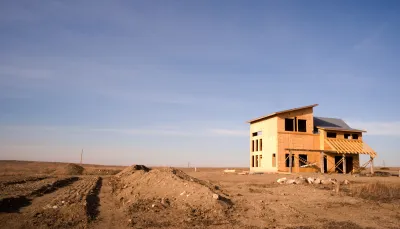Neoliberal politics have built an artificial wall between the public and private sectors when it comes to housing. It’s time for a different paradigm.

We are in the midst of the greatest affordable housing crisis in American history. Even before the pandemic, increases in rents and home prices in urban areas outpaced the increase in wages for most working families. Now, pandemic-induced unemployment is about to cause more people to lose their homes, and many more tenants to be evicted. This severe and persistent crisis calls for a new approach to the provision of housing.
Housing in the United States is uniquely inequitable, even among advanced countries. Data for OECD nations show that the U.S. has one of the highest housing cost burdens in the bottom quintile, in which the median household is spending over half its income on housing, whether it owns or rents. The U.S. has the largest gap in housing cost burdens between the bottom and middle-income quintiles for a median household in the private market, including those with subsidized rents. Yet many of the essential workers who keep our cities functional even during a health emergency are at the bottom of the income ladder. These cost burdens affect owners and renters alike, particularly millennials looking to enter homeownership. The future of the American city itself is at stake.
“Unhousing” the Public Sector
There is no true “public option” in the development of housing in the United States, and definitely none that is available and accessible to most Americans. Each public sector entity works within its own bureaucratic silo with limited accountability. This “unhousing” of the public sector under the neoliberal model has made it easy to villainize the public sector. It has opened the door for criticisms such as that “Big Government” taxes some people to subsidize others, passes regulations to address social issues that make housing an unprofitable commodity, and is an inefficient gatekeeper for private property rights through land-use zoning. Private builders perpetually blame government bureaucrats and politicians for the housing crisis, often while shirking their own social responsibilities.
And yet the abstract distinction between public and private dollars failed to hold up when publicly backed companies, known as government-sponsored enterprises (GSEs), especially Fannie Mae and Freddie Mac, bought the private mortgages of millions of Americans during the Great Recession. These enterprises are currently considering one of the largest public offerings in history to undo these governmental bailouts, and are being advised in this process by Wall Street giants JPMorgan Chase and Morgan Stanley.
A new model of housing provision could harness the collective capacity for concerted social action put into motion by emerging social movements. If we break down these artificial walls, we could marshal the best qualities of both the public and private sectors to provide affordable and accessible housing for all Americans.
FULL STORY: We Need a Federal Housing Agency

Analysis: Cybertruck Fatality Rate Far Exceeds That of Ford Pinto
The Tesla Cybertruck was recalled seven times last year.

National Parks Layoffs Will Cause Communities to Lose Billions
Thousands of essential park workers were laid off this week, just before the busy spring break season.

Retro-silient?: America’s First “Eco-burb,” The Woodlands Turns 50
A master-planned community north of Houston offers lessons on green infrastructure and resilient design, but falls short of its founder’s lofty affordability and walkability goals.

Test News Post 1
This is a summary

Analysis: Cybertruck Fatality Rate Far Exceeds That of Ford Pinto
The Tesla Cybertruck was recalled seven times last year.

Test News Headline 46
Test for the image on the front page.
Urban Design for Planners 1: Software Tools
This six-course series explores essential urban design concepts using open source software and equips planners with the tools they need to participate fully in the urban design process.
Planning for Universal Design
Learn the tools for implementing Universal Design in planning regulations.
EMC Planning Group, Inc.
Planetizen
Planetizen
Mpact (formerly Rail~Volution)
Great Falls Development Authority, Inc.
HUDs Office of Policy Development and Research
NYU Wagner Graduate School of Public Service

























